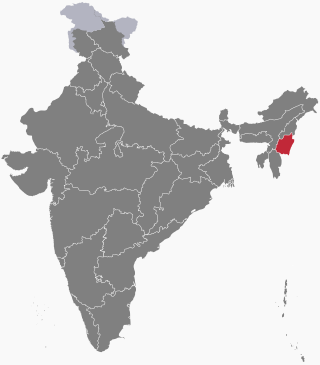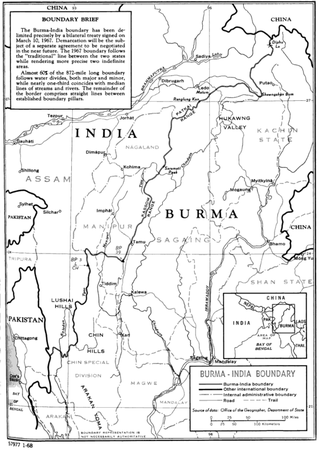
Manipur is a state in northeast India, with the city of Imphal as its capital. It is bounded by the Indian states of Nagaland to the north, Mizoram to the south and Assam to the west. It also borders two regions of Myanmar, Sagaing Region to the east and Chin State to the south. The state covers an area of 22,327 km2 (8,621 sq mi). The official and most widely spoken language is the Meitei language. Native to the Meitei people, it is also used as a lingua franca by smaller communities, who speak a variety of other Tibeto-Burman languages. Manipur has been at the crossroads of Asian economic and cultural exchange for more than 2,500 years. This exchange connects the Indian subcontinent and Central Asia to Southeast Asia, East Asia, Siberia, regions in the Arctic, Micronesia and Polynesia enabling migration of people, cultures and religions.

The Insurgency in Northeast India involves multiple separatist militant groups operating in some of India's northeastern states, which are connected to the rest of India by the Siliguri Corridor, a strip of land as narrow as 14.29 miles (23.00 km) wide.
The Paite people are an ethnic group in Northeast India, mainly living in Manipur and Mizoram. The Paites are recognized as a scheduled tribe in these two states. They are part of the Kuki-Zo people, but prefer to use the Zomi identity. "Guite" is a major clan of the Paite people.

Ukhrul district is an administrative district of the state of Manipur in India with its headquarters at Ukhrul. The Ukhrul district has a long history dating back to the 1920s when it was created as the North-East Hill Sub-Division of the then princely state of Manipur. In 2016, the Kamjong subdivision of the Ukhrul district was spun out as a separate district, leading to the present configuration of the Ukhrul district.
Moreh is a border town located on the India–Myanmar border in Tengnoupal district of the Indian state of Manipur. As a rapidly developing international trade point with the integrated customs and international immigration checkpoint, Moreh plays an important role in India's Look East Policy, trade and commerce under ASEAN–India Free Trade Area, India-Myanmar relationship, India–Myanmar–Thailand road connectivity, and Trans-Asian Railway connectivity.

The National Socialist Council of Nagaland (NSCN) is a Naga militant and separatist group operating mainly in northeastern part of India, with minor activities in northwest Myanmar (Burma). The main aim of the organisation is allegedly to establish a sovereign Naga state, "Nagalim", which would consist of all the areas inhabited by Naga tribes in Northeast India and northwest Myanmar. India claims that China and Pakistan provide financial support and weaponry to the NSCN. Drug trafficking and extortion are believed to be other major sources of income for the NSCN.
The Kuki–Paite Conflict, also called Kuki–Zomi Conflict, was an ethnic conflict during 1997–1998 between tribal communities in Churachandpur district in Manipur, India. The conflict started when a Kuki insurgent group, KNF, mercilessly killed 10 Paite villagers of Saikul Village on June 24, 1997, which led to pitting one group that subscribed to the Kuki label against another group that subscribed to the Zomi label, the latter being led by the Paites. The conflict lasted for over a year, during which 352 people died, thousands of homes were destroyed and over 13,000 people were displaced. The Government of India sent in the Indian Army to attempt to stop the violence, but peace was restored in September–October 1998 only with the initiative of the Church.

The Zomi Revolutionary Army (ZRA) is an armed Zomi nationalist militant group formed in 1997, following an increase in ethnic tensions between the Kuki people and the Paites tribe in Churachandpur district of Manipur, India. Its parent organisation, the Zomi Re-unification Organisation, was founded in April 1993.
The northeastern Indian state of Manipur has a relatively large population of Tamils, largely concentrated near the border of Myanmar. The town of Moreh in particular has an estimated 17,000 Tamils. Tamils in Manipur have relatives and business contacts in Myanmar, which is a valuable network facilitating cross-border trade.

Zale'n-gam or Zalengam (Thadou-Kuki) dialect for 'land of freedom'), also known as Kukiland is a proposed state by Kuki people, with the intention of uniting all the Kuki tribes under a single government. The proposed state's main proponents are the Kuki National Organisation and its armed wing, the Kuki National Army.

The Insurgency in Manipur is an ongoing armed conflict between India and a number of separatist rebel groups, taking place in the state of Manipur. The Insurgency in Manipur is part of the wider Insurgency in Northeast India; it displays elements of a national liberation war as well as an ethnic conflict.

The Kuki National Army (KNA) is a Kuki insurgent group active in Upper Myanmar and in pockets of Northeast India. It is the armed wing of the Kuki National Organisation.
The Kuki National Organization (KNO) is a political organization established in 1988, with the aim of representing the interests of the Kuki people in northeast India and northwest Myanmar (Burma). The organization operates alongside its principal armed wing, the Kuki National Army (KNA), and has been active in advocating for the rights and aspirations of the Kuki community.

The 1993 Manipur riot refers to the Hindu-Muslim riot following the deaths of the Meitei Pangals and the Hindu Meiteis, on 3 May 1993. In the past, there has been some land disputes and fear of Bengali Muslim influx.
On 3 May 2023, ethnic violence erupted in India's north-eastern state of Manipur between the Meitei people, a majority that lives in the Imphal Valley, and the Kuki-Zo tribal community from the surrounding hills. According to government figures, as of 3 May 2024, 221 people have been killed in the violence and 60,000 people have been displaced. Earlier figures also mentioned over 1,000 injured, and 32 missing. 4,786 houses were burnt and 386 religious structures were vandalized, including temples and churches. Unofficial figures are higher.

Arambai Tenggol is a Meitei activist organisation in the Indian state of Manipur founded by Manipur's titular ling and Rajya Sabha member Leishemba Sanajaoba, who also remains as its chairman. Arambai Tenggol has been described as a radical organisation, or as a radicalised armed militia. It is also a revivalist organisation that aims to reestablish the pre-Hindu, native Sanamahi religion among the Meiteis. It enjoys the patronage of Sanajaoba as well as the chief minister N. Biren Singh. During the 2023–2024 Manipur violence, members of the Kuki-Zo community blamed it for having carried out deadly attacks against them. In January 2024, the organisation demonstrated its influence by summoning all the elected Meitei legislators of the state for a meeting to deliberate on the defence of Meiteis in the prevailing conflict.

The 2024 Indian general election was held in Manipur on 19 April and 26 April to elect two members of the 18th Lok Sabha, from the constituencies of Inner Manipur and Outer Manipur. The election got scheduled in the midst of year-long ethnic violence between the valley-based Meitei community and the hill-based Kuki-Zo community. There were reports of violence and intimidation by armed militias during the campaigning as well as polling but, on the whole, the election got conducted peacefully. Opposition Indian National Congress candidates, Bimol Akoijam and Alfred Kanngam Arthur, won the two seats respectively.
The International Meeteis Forum is a Meitei ethnic advocacy group in the Indian state of Manipur. Its objectives are to assert Meitei indigeneity in Manipur, to unify Meiteis around the world, to campaign for the territorial integrity of the Manipur state and to block the influx of alleged foreigners. Founded in 2012 by a retired army officer R. K. Rajendro, it later teamed up with the Federation of Haomee with similar ideological motivations. Both the organisations generated free-flowing hate speech against the Kuki community of Manipur, labelling them as "immigrants" or "foreigners", which was instrumental in the generation of 2023 Manipur violence.
The Khamenlok search operation on 12–14 June 2023, in the course of 2023–2024 Manipur violence between the Meitei and Kuki people, in the Khamenlok river valley, a branch valley of the Iril River valley, in the Saikul subdivision of Kangpokpi district. According to intelligence reports, the Manipur police received information that more than 3,000 Meitei militants, some armed with sophisticated weapons, launched an attack on the kuki villages in the Khamenlok and surrounding areas. Over a period of three days, the meiteis burned houses and rampaged through the area. While the kuki villagers escaped upon the arrival of the assailants, the Assam Rifles were blocked from reaching the area by Meitei women. Finally, on June 13, while the assailants were celebrating in a church building, the kuki village defense volunteers descended from hills and carried out a wholesale massacre of the meiteis mobs. The official death count was thirteen people, but unofficial estimates were in excess of 200 people.

Throughout the long-running separatist insurgencies in Northeast India, dozens of India-based insurgent groups have been involved in the neighboring conflict in Myanmar, both sheltering in Myanmar from the counterinsurgent Assam Rifles and participating in the conflict itself. Outside of several Indian-led operations, including Operation Golden Bird in 1995, Operation Hot Pursuit in 2015, or Operation Sunrise I and II in 2019, areas in which these insurgent groups are active have scarcely experienced fighting. Amid the escalation of civil war in Myanmar from 2021, several sources claim that the majority of Indian ethnic armed organisations (IEAOs) are allied, or have some level of understanding, with the ruling military junta of Myanmar, who allows them to maintain bases inside mountainous areas of northern Myanmar, typically in return for the IEAOs attacking anti-junta resistance groups.










